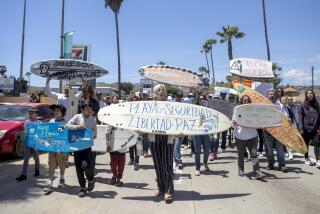Women’s Rights Are the Same as Human Rights : Abuse: We must stop trivializing sexual crimes by calling them customs.
Are genital mutilation, forced prostitution, marital rape, murder of raped daughters, deaths resulting from dowry disputes merely customs, or do they constitute violations of human rights? Spurred by the spread of global feminism, some activists are seeking to redefine the hidden injuries of sex as violations of women’s human rights.
Before the women’s movement, many such cruelties were not defined as crimes. During the last two decades, however, feminists in the United States and elsewhere named the sexual crimes women had once suffered in silence. Wife-battering, rape, incest, sexual harassment, sexual slavery, to name but a few, are no longer protected by archaic laws. Still, such crimes continue to be called, and regarded, as “women’s issues.” As a result, they are trivialized as cultural problems.
Charlotte Bunch, the director of the Douglass College Center for Global Issues and Women’s Leadership, has taken a leading role in persuading human-rights organizations to reconsider sexual crimes and violence against women as human-rights abuses. Bunch notes that the typical victim of human-rights abuses is portrayed as a male dissident tortured or imprisoned by the state. Women, she observes, suffer equally egregious crimes, but most often at the hands of relatives in their own homes.
The American legal system’s emphasis on civil and political rights is not sufficiently elastic to create a broader definition of human rights. Instead, feminists like Bunch look to the Universal Declaration of Human Rights, adopted Dec. 10, 1948, by the United Nations. Although gender is not specifically addressed, the declaration defines bodily integrity, along with shelter, food and work, as a basic human right. Still, most human-rights groups dismiss sexual crimes as matters of culture.
But as Bunch warns, gender-specific crimes are not only unpleasant, they also maim and kill women. Consider, for example:
-- In the United States, a rape is committed every six minutes and battery is the leading cause of injury to adult women.
-- In places as diverse as Bangladesh, Canada, Kenya and Thailand, 50% of female homicides are committed by family members.
-- In India, eight out of 10 wives are victims of violence from domestic battery or dowry-related abuses. In the worst cases, dowry disputes result in death.
-- Amniocentesis used for sex selection leads to the abortion of more female than male fetuses, as high as 99% in Bombay.
-- During childhood, the World Health Organization reports, girls are fed less, breast-fed for shorter periods of time, brought to doctors less often and suffer from malnutrition more often than boys.
-- In adulthood, untold numbers of women suffer serious health complications from illegal abortions and genital mutilation.
Use the language of human rights and what seemed to be customs begin to look like human-rights abuses. Slavery (forced prostitution), sexual terrorism (rape), imprisonment (confinement to the home) and torture (systematic battery) are considered major human-rights violations.
Why bother to redefine women’s rights as human rights? Because they provide moral touchstones against which we can measure a society’s treatment of any individual or group. As the democratic opposition demonstrated in Eastern Europe and the Soviet Union, the demand for human rights challenges arbitrary violence and coercion and creates a framework for a more democratic society.
The language of human rights also has immediate political consequences. When an Indian woman escapes an arranged marriage and or a raped Bangladesh girl is threatened with death by male relatives, they are usually refused political asylum by Western nations. These are customs, they are told, not human-rights violations.
In 1979, the U.N. Convention on the Elimination of All Forms of Discrimination Against Women began addressing violations of women’s political and legal rights. As of 1990, 104 nations--the United States is not among them--have ratified the convention. Amnesty International publicizes violations of women prisoners. The next step, however, is to recognize that women, unlike men, suffer more often at the hands of relatives and other citizens than from state-sanctioned violence. The tactics used to publicize the torture and imprisonment of men--reports and letters to heads of state--do not meet the needs of women. Activists must publicize and challenge the laws and customs that violate women’s most fundamental human rights.
To expand our idea of human rights is to challenge the cultural relativism that currently protects sexual crimes and violence against women’s bodily integrity. Human-rights activists must find the courage to call a custom a crime. Slavery, we should remember, was once a legally supportable and culturally acceptable institution.
More to Read
Start your day right
Sign up for Essential California for news, features and recommendations from the L.A. Times and beyond in your inbox six days a week.
You may occasionally receive promotional content from the Los Angeles Times.






